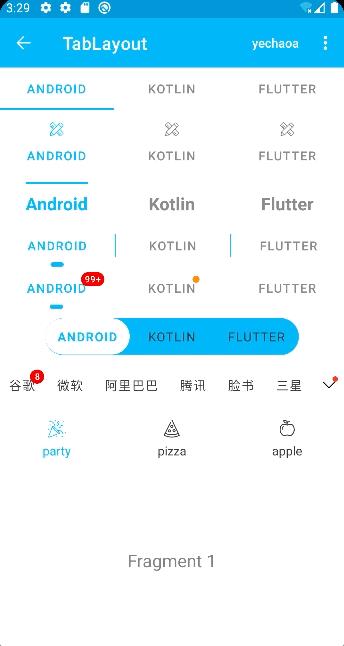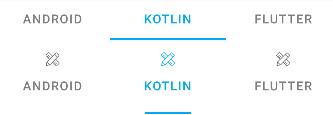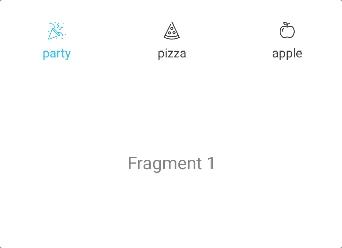Android原生TabLayout使用全解析,看这篇就够了
Posted yechaoa
tags:
篇首语:本文由小常识网(cha138.com)小编为大家整理,主要介绍了Android原生TabLayout使用全解析,看这篇就够了相关的知识,希望对你有一定的参考价值。
前言
为什么会有这篇文章呢,是因为之前关于TabLayout的使用陆陆续续也写了好几篇了,感觉比较分散,且不成体系,写这篇文章的目的就是希望能把各种效果的实现一次性讲齐,所以也有了标题的「看这篇就够了」。
TabLayout作为导航组件来说,使用场景非常的多,也意味着要满足各种各样的需求。
在效果实现上,有同学会选择自定义View来做,定制性高,但易用性、稳定性、维护性不敢保证,使用官方组件能避免这些不确定性,一是开源,有很多大佬共建,会不停的迭代;二是经过大型app验证,比如google play;有了这两点,基本可以放心大胆的使用官方组件了。
那可能有的同学又会说,道理我都懂,可是不满足需求啊,只能自定义了。是的,早期的api确实不够丰富,在某些需求的实现上显得捉襟见肘,但是google也在不断的迭代,目前为止,常见的样式都能满足。
效果图

简介

- TabLayout:一个横向可滑动的菜单导航ui组件
- Tab:TabLayout中的item,可以通过newTab()创建
- TabView:Tab的实例,是一个包含ImageView和TextView的线性布局
- TabItem:一种特殊的“视图”,在TabLayout中可以显式声明Tab
功能拆解
Material Design 组件最新正式版依赖:
implementation 'com.google.android.material:material:1.5.0'
1.基础实现
1.1 xml动态写法
<com.google.android.material.tabs.TabLayout
android:id="@+id/tab_layout1"
android:layout_width="match_parent"
android:layout_height="wrap_content"
android:background="@color/white"
app:tabIndicatorColor="@color/colorPrimary"
app:tabMaxWidth="200dp"
app:tabMinWidth="100dp"
app:tabMode="fixed"
app:tabSelectedTextColor="@color/colorPrimary"
app:tabTextColor="@color/gray" />
只写一个Layout,item可以配合ViewPager来生成。
1.2 xml静态写法
<com.google.android.material.tabs.TabLayout
android:layout_height="wrap_content"
android:layout_width="match_parent">
<com.google.android.material.tabs.TabItem
android:text="@string/tab_text"/>
<com.google.android.material.tabs.TabItem
android:icon="@drawable/ic_android"/>
</com.google.android.material.tabs.TabLayout>
属于固定写法,比如我们非常确定item有几个,可以通过TabItem显式声明。
1.3 kotlin/java代码写法
val tab = mBinding.tabLayout7.newTab()
tab.text = it.key
//...
mBinding.tabLayout7.addTab(tab)
这种情况适合Tab的数据是动态的,比如接口数据回来之后,再创建Tab并添加到TabLayout中。
2.添加图标
mBinding.tabLayout2.getTabAt(index)?.setIcon(R.mipmap.ic_launcher)
获取Tab然后设置icon。
Tab内部其实是一个TextView和ImageView,添加图标就是给ImageView设置icon。
3.字体大小、加粗
通过app:tabTextAppearance给TabLayout设置文本样式
<com.google.android.material.tabs.TabLayout
...
app:tabTextAppearance="@style/MyTabLayout"
/>
style:
<style name="MyTabLayout">
<item name="android:textSize">20sp</item>
<item name="android:textStyle">bold</item>
<item name="android:textAllCaps">false</item>
</style>
比如这里设置了字体大小和加粗。
默认字体大小14sp:
<dimen name="design_tab_text_size">14sp</dimen>
4.去掉Tab长按提示文字

长按Tab时会有一个提示文字,类似Toast一样。
/**
* 隐藏长按显示文本
*/
private fun hideToolTipText(tab: TabLayout.Tab)
// 取消长按事件
tab.view.isLongClickable = false
// api 26 以上 设置空text
if (Build.VERSION.SDK_INT > Build.VERSION_CODES.O)
tab.view.tooltipText = ""
可以取消长按事件,在api26以上也可以设置提示文本为空。
5.去掉下划线indicator
app:tabIndicatorHeight="0dp"
设置高度为0即可。
注意,单纯设置tabIndicatorColor为透明,其实不准确,默认还是有2dp的,根本瞒不过射鸡师的眼睛。
6.下划线的样式

通过app:tabIndicator可以设置自定义的样式,比如通过shape设置圆角和宽度。
<com.google.android.material.tabs.TabLayout
...
app:tabIndicator="@drawable/shape_tab_indicator"
app:tabIndicatorColor="@color/colorPrimary"
/>
注意:Indicator的颜色在shape中设置是无效的,需要通过app:tabIndicatorColor设置才可以
shape:
<?xml version="1.0" encoding="utf-8"?>
<layer-list xmlns:android="http://schemas.android.com/apk/res/android">
<item
android:width="15dp"
android:height="5dp"
android:gravity="center">
<shape>
<corners android:radius="5dp" />
<!--color无效,源码用tabIndicatorColor-->
<solid android:color="@color/colorPrimary" />
</shape>
</item>
</layer-list>
7.下划线的宽度

默认情况下,tabIndicator的宽度是填充整个Tab的,比如上图中的第一个,我们可以简单的设置不填充,与文本对齐,即第二个效果
app:tabIndicatorFullWidth="false"
也可以像上一节那样,通过shape自定义tabIndicator的宽度。
8.Tab分割线

/** A @link LinearLayout containing @link Tab instances for use with @link TabLayout. */
public final class TabView extends LinearLayout
通过源码可以看到内部实现TabView继承至LinearLayout,我们知道LinearLayout是可以给子view设置分割线的,那我们就可以通过遍历来添加分割线
//设置 分割线
for (index in 0..mBinding.tabLayout4.tabCount)
val linearLayout = mBinding.tabLayout4.getChildAt(index) as? LinearLayout
linearLayout?.let
it.showDividers = LinearLayout.SHOW_DIVIDER_MIDDLE
it.dividerDrawable = ContextCompat.getDrawable(this, R.drawable.shape_tab_divider)
it.dividerPadding = 30
shape_tab_divider:
<?xml version="1.0" encoding="utf-8"?>
<shape xmlns:android="http://schemas.android.com/apk/res/android">
<solid android:color="@color/colorPrimary" />
<size android:width="1dp" android:height="10dp" />
</shape>
9.TabLayout样式

上图中的效果其实是TabLayout样式+tabIndicator样式形成的一个「整体」的效果。
TabLayout是两边半圆的一个长条,这个我们通过编写shape设置给其背景即可实现。
shape_tab_bg:
<?xml version="1.0" encoding="utf-8"?>
<shape xmlns:android="http://schemas.android.com/apk/res/android">
<corners android:radius="999dp" />
<solid android:color="@color/colorPrimary" />
</shape>
这个效果的关键在于tabIndicator的高度与TabLayout的高度相同,所以二者高度设置一致即可。
shape_full_tab_indicator:
<?xml version="1.0" encoding="utf-8"?>
<layer-list xmlns:android="http://schemas.android.com/apk/res/android">
<item android:gravity="center" android:top="0.5dp" android:bottom="0.5dp">
<shape>
<!-- 上下边距合计1dp 高度减少1dp -->
<size android:height="41dp" />
<corners android:radius="999dp" />
<solid android:color="@color/white" />
</shape>
</item>
</layer-list>
TabLayout:
<com.google.android.material.tabs.TabLayout
android:id="@+id/tab_layout6"
android:layout_width="wrap_content"
android:layout_height="42dp"
android:layout_gravity="center"
android:layout_marginTop="10dp"
android:background="@drawable/shape_tab_bg"
app:tabIndicator="@drawable/shape_full_tab_indicator"
app:tabIndicatorColor="@color/white"
app:tabIndicatorFullWidth="true"
app:tabIndicatorHeight="42dp"
app:tabMinWidth="96dp"
app:tabMode="fixed"
app:tabSelectedTextColor="@color/colorPrimary"
app:tabTextColor="@color/black" />
10.Tab添加小红点

添加小红点的功能还是比较常见的,好在TabLayout也提供了这种能力,其实添加起来也非常简单,难在未知。
可以设置带数字的红点,也可以设置没有数字单纯的一个点。
通过getOrCreateBadge可以对红点进行简单的配置:
// 数字
mBinding.tabLayout5.getTabAt(defaultIndex)?.let tab ->
tab.orCreateBadge.apply
backgroundColor = Color.RED
maxCharacterCount = 3
number = 99999
badgeTextColor = Color.WHITE
// 红点
mBinding.tabLayout5.getTabAt(1)?.let tab ->
tab.orCreateBadge.backgroundColor = ContextCompat.getColor(this, R.color.orange)
getOrCreateBadge实际上是获取或创建BadgeDrawable。
通过源码发现,BadgeDrawable除了TabLayout引用之外,还有NavigationBarItemView、NavigationBarMenuView、NavigationBarView,意味着它们也同样具备着小红点这种能力。其实别的view也是可以具备的。
关于小红点这里就不展开了,非常推荐查看我之前写的这篇:【涨姿势】你没用过的BadgeDrawable
Author:yechaoa
11.获取隐藏的Tab

上一节中我们实现了小红点效果,那如果一屏显示不够的情况下,如何提示未展示的信息呢,比如上面我们如何把未显示的tab且有数字的Tab提示出来呢?常见的解决方案都是在尾部加一个红点提示。
那么问题来了,如何判断某一个Tab是否可见呢,翻看了源码,可惜并没有提供相应的api,那只能我们自己实现了。
我们前面添加小红点是根据Tab添加的,Tab内部实现也是一个view,那view就可以判断其是否可见。
private fun isShowDot(): Boolean
var showIndex = 0
var tipCount = 0
companyMap.keys.forEachIndexed index, _ ->
mBinding.tabLayout7.getTabAt(index)?.let tab ->
val tabView = tab.view as LinearLayout
val rect = Rect()
val visible = tabView.getLocalVisibleRect(rect)
// 可见范围小于80%也在计算范围之内,剩下20%宽度足够红点透出(可自定义)
if (visible && rect.right > tab.view.width * 0.8)
showIndex = index
else
//if (index > showIndex) // 任意一个有count的tab隐藏就会显示,比如第一个在滑动过程中会隐藏,也在计算范围之内
if (index > lastShowIndex) // 只检测右侧隐藏且有count的tab 才在计算范围之内
tab.badge?.let tipCount += it.number
lastShowIndex = showIndex
return tipCount > 0
上面的方法中就是判断是否需要显示右侧提示的小红点。
计算规则:Tab不可见,且Tab上的红点数字大于0的即在计算范围之内。
这里有一个优化的点,比如上图中的“腾讯”Tab,它是可见的,但是红点不可见,那么问题就来了,如果我们没有提示到,是很容易产生客诉的,所以这里在计算的时候也加了一个条件,就是可见范围小于80%也在计算范围之内,剩下20%的宽度是足够Tab上的红点透出的(也可自定义)。
同时在TabLayout滑动的过程中也应该加上判断显示的逻辑:
// mBinding.tabLayout7.setOnScrollChangeListener() // min api 23 (6.0)
// 适配 5.0 滑动过程中判断右侧小红点是否需要显示
mBinding.tabLayout7.viewTreeObserver.addOnScrollChangedListener
mBinding.vArrowDot.visibility = if (isShowDot()) View.VISIBLE else View.INVISIBLE
还有初始化时的判断逻辑:
override fun onResume()
super.onResume()
// 初始化判断右侧小红点是否需要显示
mBinding.tabLayout7.viewTreeObserver.addOnGlobalLayoutListener(object : ViewTreeObserver.OnGlobalLayoutListener
override fun onGlobalLayout()
mBinding.vArrowDot.visibility = if (isShowDot()) View.VISIBLE else View.INVISIBLE
mBinding.tabLayout7.viewTreeObserver.removeOnGlobalLayoutListener(this)
)
12.Tab宽度自适应

细心的同学会发现,这个TabLayout的item左右间距都是一样的,不管标题是两个字还是四个字的,左右间距都是相等的,而实际上的效果是两个字的Tab要比四个字的Tab左右间距要大一些的,那这个效果是怎么实现的呢?
实际上是我们设置了tabMinWidth:
app:tabMinWidth="50dp"
源码中默认的是:
private int getTabMinWidth()
if (requestedTabMinWidth != INVALID_WIDTH)
// If we have been given a min width, use it
return requestedTabMinWidth;
// Else, we'll use the default value
return (mode == MODE_SCROLLABLE || mode == MODE_AUTO) ? scrollableTabMinWidth : 0;
- requestedTabMinWidth是根据xml设置获取的。
- 假如xml没设置tabMinWidth的情况下,且tabMode是
scrollable的情况下,会返回默认配置,否则为0,即tabMode为fixed的情况。
系统默认配置scrollableTabMinWidth:
<dimen name="design_tab_scrollable_min_width">72dp</dimen>
在两个字和四个字的标题都存在的情况下,两个字用这个默认宽度就会有多余的间距,所以会出现间距不均等的情况,通过设置覆盖默认即可解决。
13.自定义Item View

前面讲到Tab内部实现是一个View,那我们就可以通过官方提供api(setCustomView)来自定义这个view。
setCustomView的两种方式:
- public Tab setCustomView(@Nullable View view)
- public Tab setCustomView(@LayoutRes int resId)
我们先编写一个自定义的布局文件,布局文件比较简单,一个LottieAnimationView和TextView。

再通过Tab添加进去即可。
val animMap = mapOf("party" to R.raw.anim_confetti, "pizza" to R.raw.anim_pizza, "apple" to R.raw.anim_apple)
animMap.keys.forEach s ->
val tab = mBinding.tabLayout8.newTab()
val view = LayoutInflater.from(this).inflate(R.layout.item_tab, null)
val imageView = view.findViewById<LottieAnimationView>(R.id.lav_tab_img)
val textView = view.findViewById<TextView>(R.id.tv_tab_text)
imageView.setAnimation(animMap[s]!!)
imageView.setColorFilter(Color.BLUE)
textView.text = s
tab.customView = view
mBinding.tabLayout8.addTab(tab)
14.使用Lottie

Lottie是一个可以在多平台展示动画的库,相信很多同学都已经用过了,就不详细展开了,感兴趣的可以查看Lottie官方文档。
Lottie依赖:
implementation "com.airbnb.android:lottie:5.0.1"
上一节中我们实现了自定义TabLayout的Item View,在这个自定义的布局中,我们用LottieAnimationView来承载动画的展示。
<?xml version="1.0" encoding="utf-8"?>
<androidx.appcompat.widget.LinearLayoutCompat xmlns:android="http://schemas.android.com/apk/res/android"
xmlns:app="http://schemas.android.com/apk/res-auto"
android:id="@+id/item_tab"
android:layout_width="match_parent"
android:layout_height="wrap_content"
android:gravity="center"
android:orientation="vertical">
<com.airbnb.lottie.LottieAnimationView
android:id="@+id/lav_tab_img"
android:layout_width="30dp"
android:layout_height="30dp"
app:lottie_colorFilter="@color/black"
app:lottie_rawRes="@raw/anim_confetti" />
<TextView
android:id="@+id/tv_tab_text"
android:layout_width="wrap_content"
android:layout_height="wrap_content"
android:text="@string/app_name"
android:textColor="@color/black"
android:textSize="14sp" />
</androidx.appcompat.widget.LinearLayoutCompat>
添加的方式也在上一节中讲过了,我们只需要控制好选中、未选中的状态即可。
mBinding.tabLayout8.addOnTabSelectedListener(object : OnTabSelectedListener
override fun onTabSelected(tab: TabLayout.Tab?)
tab?.setSelected()
tab?.let mBinding.viewPager.currentItem = it.position
override fun onTabUnselected(tab: TabLayout.Tab?)
tab?.setUnselected()
override fun onTabReselected(tab: TabLayout.Tab?)
)
这里通过两个扩展方法分别处理不同的状态。
- 选中状态,播放动画并设置icon颜色
/**
* 选中状态
*/
fun TabLayout.Tab.setSelected()
this.customView?.let以上是关于Android原生TabLayout使用全解析,看这篇就够了的主要内容,如果未能解决你的问题,请参考以下文章